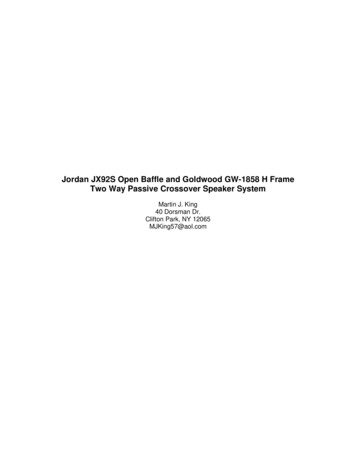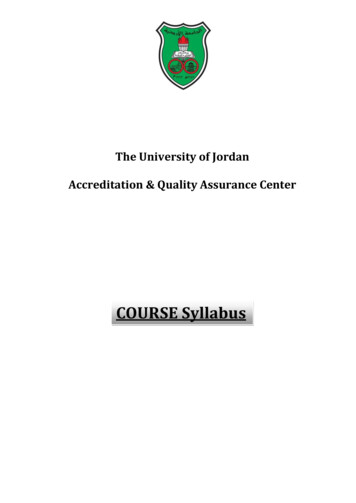
Transcription
Jordan JX92S Open Baffle and Goldwood GW-1858 H FrameTwo Way Passive Crossover Speaker SystemMartin J. King40 Dorsman Dr.Clifton Park, NY 12065MJKing57@aol.com
Jordan JX92S Open Baffle and Goldwood GW-1858 H Frame Two Way Passive Crossover Speaker SystemBy Martin J. King, 02/07/09Copyright 2009 by Martin J. King. All Rights Reserved.Introduction :My first article about this project documented the design and build of a compact,cost-effective, two-way dipole speaker system that covered as much of the 20 Hz to 20kHz frequency range as possible. Figures 1 and 2 show the resulting combination of aGoldwood GW-1858 18” woofer in an H frame and a Jordan JX92S full range drivermounted on an open baffle. I drove this speaker using an active crossover, and a pair of200 watt SS amps, to handle the frequency filtering and any required SPL levelingbetween the two drivers. The intent was to relieve the full range driver of the lowest bassfrequencies and allow it to do what it does best with the remainder of the audiospectrum. I have been listening to this speaker for the past six months and have learneda lot and enjoyed the performance as it has evolved into today’s version.When I first configured the active crossover, I programmed a 2nd order LinkwitzRiley low pass crossover at 100 Hz with 2.5 dB of boost for the Goldwood woofer andprogrammed a 2nd order Linkwitz-Riley high pass crossover at 250 Hz for the Jordan fullrange driver. I played with the crossover points and slopes for a while but eventuallyended up returning to this configuration as my preferred set-up.The next thing I tried adjusting was the amount of bass boost. Starting with 2.5dB yielded bass you could hear and feel in sufficient quantities and was very satisfyingand entertaining. But the 2.5 dB setting sometimes left the speaker with a slightlydarker sound. Adjusted the boost down to 1 or 1.5 dB voiced the system to have moreof the midrange magic, typically associated with full range drivers, while still retainedmost of the bass presence. All three of these boost settings worked well and differentpersonal tastes or styles of music might lead one to prefer one over the others. Basedon this experience I started to think about exploring the possibility of a completelypassive crossover.Seeing the document’s title, it should be obvious that I have a passive crossoveroption to present for the Goldwood woofer and Jordan full range driver design shown inFigures 1 and 2. A passive design should be much more attractive to DIYers since theexpense of an additional amp is avoided. In addition, I am also going to use thisopportunity to demonstrate a new MathCad based method of calculation that includesroom effects. I will present correlations of calculated SPL responses with SPLmeasurements made in my listening room. These are the two goals of this documentand the following pages provide the details.Passive Crossover Design :I started sizing the passive crossover using text book equations to calculatecomponent values using the voice coil DC resistances. Clearly this is only a startingpoint to get ballpark inputs for a MathCad worksheet that handles passive crossovers inthe calculation of the system SPL response. The calculations included the interactionbetween the passive crossovers and the actual voice coil complex impedances. Then byiterating component values, and watching the summed SPL response, I worked my waytowards a set of component values that produced an on axis SPL response that trackedthe goal function used in the earlier active crossover design article. Figure 3 shows theschematic of the final crossovers and a parts list with component prices. The actualcrossovers are shown in Figure 4 just prior to installation.Page 1 of 17
Jordan JX92S Open Baffle and Goldwood GW-1858 H Frame Two Way Passive Crossover Speaker SystemBy Martin J. King, 02/07/09Copyright 2009 by Martin J. King. All Rights Reserved.Figure 1 : Front ViewPage 2 of 17
Jordan JX92S Open Baffle and Goldwood GW-1858 H Frame Two Way Passive Crossover Speaker SystemBy Martin J. King, 02/07/09Copyright 2009 by Martin J. King. All Rights Reserved.Figure 2 : Rear ViewPage 3 of 17
Jordan JX92S Open Baffle and Goldwood GW-1858 H Frame Two Way Passive Crossover Speaker SystemBy Martin J. King, 02/07/09Copyright 2009 by Martin J. King. All Rights Reserved.Figure 3 : Crossover Schematics and Parts List51 µF eg5.6 mHJordan JX92S--13 mH 150 µFeg-Goldwood GW-1858-Crossover Cost CalculationLow Pass for Goldwood GW-1858L1 13 mHERSE Super Q 16 AWGC2 150 uFERSE 400VUnit Cost 25.05 32.60High Pass for JX92SC1 51 uFERSE 250VL2 5.6 mHERSE Super Q 16 AWG 11.36 19.70Total Cost 177.42http://www.erseaudio.com/Page 4 of 17
Jordan JX92S Open Baffle and Goldwood GW-1858 H Frame Two Way Passive Crossover Speaker SystemBy Martin J. King, 02/07/09Copyright 2009 by Martin J. King. All Rights Reserved.Figure 4 : As-Built CrossoversHigh Pass : Jordan Full Range DriverLow Pass : Goldwood WooferPage 5 of 17
Jordan JX92S Open Baffle and Goldwood GW-1858 H Frame Two Way Passive Crossover Speaker SystemBy Martin J. King, 02/07/09Copyright 2009 by Martin J. King. All Rights Reserved.The simulation results for the active crossover, copied from the previous article,and for the new passive crossover are shown below in Figure 5. Comparing the twocurves you can see the similarity of the SPL response results. I was surprised at firstbecause the active crossover simulation still had 2.5 dB of bass boost applied. There isno possibility of applying bass boost to a passive system and yet it appears to produceequivalent levels of bass output. I had to think about this for a while to convince myselfthat the calculations were accurate.The elevated bass output produced by the passive crossover can be explainedafter recognizing that in the passive system the large impedance peak associated withthe Goldwood driver’s resonance interacts with the crossover pushing the initial roll-off ofthe 100 Hz low pass filter higher in frequency. In an active system the filter is isolatedfrom the driver by the amp, the impedance of the driver does not interact with thecrossover filter, so the roll off is predictable and consistent with an ideal filter. Thepassive crossover’s attenuation starts higher in frequency compared to the activecrossover resulting in elevated bass output at low frequencies. This is a real advantageof the passive crossover design.Figure 5 : Simulations of Free Field SPL Response at 1 meter for 1 Watt InputActive Crossover ResponseSPL (dB)System Sound Pressure Level Magnitude110105SPLSystem 100s95SPLH Frame 90s85SPLJordan80s7570656010100 11 .1031 .1041 .104s dω HzFrequency (Hz)Passive Crossover ResponseSPL (dB)System Sound Pressure Level Magnitude110105SPLSystem 100s95SPLH Frame 90s8580SPLJordans7570656010100 1s dω HzFrequency (Hz)Page 6 of 171 .103
Jordan JX92S Open Baffle and Goldwood GW-1858 H Frame Two Way Passive Crossover Speaker SystemBy Martin J. King, 02/07/09Copyright 2009 by Martin J. King. All Rights Reserved.Measurement Results and MathCad Correlations :Originally, I measured the response of the finished speaker systems using mytwo car garage since it is a fairly large open space. That was last summer and now it iswinter in upstate New York which precludes me from performing the same set ofmeasurements with the passive crossover system. So the measurements needed to beconducted with the speakers located in my listening room.In parallel with designing and building the passive crossover, I had also beenworking on upgrading my MathCad worksheets to allow modeling a speaker systemlocated in a rectangular room. Conveniently, these two efforts came together at thesame time so I was very interested in taking the SPL measurements and seeing howwell the new MathCad calculations correlated.Real world measurements are never as clean as the plotted results we get fromthe various Thiele/Small based speaker modeling programs. As frequency increases themeasurements start to exhibit a lot of hash that is associated with the different timedelays between the sounds emanated from different points on the driver’s cone, differentbaffle edge sources, and reflections from nearby room surfaces such as walls. Figure 6is a typical example of an untreated SPL response curve taken at 1 m on the axis of theJordan full range driver. To clean up the SPL plots, 1/6 octave averaging is applied to allSPL measurements and SPL calculations presented on the following pages.Figure 6 : Untreated SPL Response MeasurementPage 7 of 17
Jordan JX92S Open Baffle and Goldwood GW-1858 H Frame Two Way Passive Crossover Speaker SystemBy Martin J. King, 02/07/09Copyright 2009 by Martin J. King. All Rights Reserved.Figures 7, 8, and 9 present the speaker impedance, the H frame and system SPLresponse at 1 m, and the H frame and system SPL response at the listening position.The SPL measurements are all taken in my listening room with the speakers located intheir preferred positions. The measured results extending from 10 Hz to 20 kHz and are1/6 octave smoothed without any gating or windowing applied.Figure 7 : Speaker System ImpedancePage 8 of 17
Jordan JX92S Open Baffle and Goldwood GW-1858 H Frame Two Way Passive Crossover Speaker SystemBy Martin J. King, 02/07/09Copyright 2009 by Martin J. King. All Rights Reserved.Figure 8 : H Frame and System SPL at 1 m on the Axis of the Jordan Full Range DriverPage 9 of 17
Jordan JX92S Open Baffle and Goldwood GW-1858 H Frame Two Way Passive Crossover Speaker SystemBy Martin J. King, 02/07/09Copyright 2009 by Martin J. King. All Rights Reserved.Figure 9 : H Frame and System SPL at the Listening PositionPage 10 of 17
Jordan JX92S Open Baffle and Goldwood GW-1858 H Frame Two Way Passive Crossover Speaker SystemBy Martin J. King, 02/07/09Copyright 2009 by Martin J. King. All Rights Reserved.The data shown in Figures 7, 8, and 9 was exported into text files and read intoMathCad for correlation with the calculated results. The MathCad model I have beendeveloping superimposes the results from the H frame and the single driver OBworksheets after applying a passive crossover. The worksheets have been upgraded toallow the speaker to be placed in an empty rectangular room. The speaker is locatedwith respect to one of the corners and can be rotated so that it is not parallel to any ofthe walls.Figure 10 shows three views of the modeled geometry for the Goldwood H frameand Jordan OB speaker system. The dark black lines outline the speaker geometry, thered circles represent the driven sources, and the blue circles represent the edgediffraction sources.Starting with the third image in Figure 10, this is a view looking down on thespeaker system (looking along the Z axis). The reference corner is located at the originof the coordinate system and the X and Y axes have units of meters. In the third imagethe speaker system is seen rotated approximately 30 degrees towards the listeningposition with respect to the side and rear walls. Recognizing that the speaker system isrotated about 30 degrees, in the first and second image the front and rear openings ofthe H frame are offset in the two views.The room being modeled is 14 feet square (4.267 m square) and assumed to beempty. Multiple reflections off of all four walls, the floor, and the ceiling are included withindependent absorption coefficients defined as functions of frequency for each reflectingsurface. The top two images in Figure 10 are the front view (looking along the X axis)and the side view (looking along the Y axis).Two listening positions were evaluated. First, a point 1 m along the axis of theJordan driver was used to assess the influences that are predominantly from cornerloading. Second, a position consistent with the my location while I am sitting andlistening to music was evaluated to assess the overall room influences on the soundfield.The same sets of plots that were shown in Figures 7, 8, and 9 were producedincluding the MathCad predictions and they are shown in Figures 11, 12, and 13. In eachplot the solid red curve represents the MathCad calculated results while the dashed bluecurve represents the Praxis tested results.Page 11 of 17
Jordan JX92S Open Baffle and Goldwood GW-1858 H Frame Two Way Passive Crossover Speaker SystemBy Martin J. King, 02/07/09Copyright 2009 by Martin J. King. All Rights Reserved.Figure 10 : Composite MathCad ModelFront View2zdzO1.5zez dfzH1z efz dr0.5z er000.511.52y d , y O , y e , y df , y H , y ef, y dr , y erSide View2zdzO1.5zez dfzH1z efz dr0.5z er000.511.521.52xd , xO , xe , xdf , xH , xef, xdr , xerTop View2ydyO1.5yey dfyH1y efy dr0.5y er000.51xd , xO , xe , xdf , xH , xef, xdr , xerPage 12 of 17
Jordan JX92S Open Baffle and Goldwood GW-1858 H Frame Two Way Passive Crossover Speaker SystemBy Martin J. King, 02/07/09Copyright 2009 by Martin J. King. All Rights Reserved.Figure 11 : Speaker System ImpedanceSystem Impedance MagnitudeImpedance (ohms)2520Zs15Test s105010100s dω Hz 11 .1031 .101 .1031 .104System Impedance PhasePhase (degrees)90arg( Z s)45degPhases0459010100 1s dω HzFrequency (Hz)Page 13 of 174
Jordan JX92S Open Baffle and Goldwood GW-1858 H Frame Two Way Passive Crossover Speaker SystemBy Martin J. King, 02/07/09Copyright 2009 by Martin J. King. All Rights Reserved.Figure 12 : H Frame and System SPL at 1 m on the Axis of the Jordan Full Range DriverSPL (dB)H Frame Sound Pressure Level Magnitude110105100SPLH Frame 95s9085Test s807570656010100 11 .1031 .104s dω HzFrequency (Hz)SPL (dB)System Sound Pressure Level Magnitude110105100SPLSystem 95s9085Test s8075706560101 .103100 1s dω HzFrequency (Hz)Page 14 of 171 .104
Jordan JX92S Open Baffle and Goldwood GW-1858 H Frame Two Way Passive Crossover Speaker SystemBy Martin J. King, 02/07/09Copyright 2009 by Martin J. King. All Rights Reserved.Figure 13 : H Frame and System SPL at the Listening Pos
passive crossover. Seeing the document’s title, it should be obvious that I have a passive crossover option to present for the Goldwood woofer and Jordan full range driver design shown in Figures 1 and 2. A passive design should be much more attractive to DIYers since the expense of an additional amp is avoided. In addition, I am also going to use this











